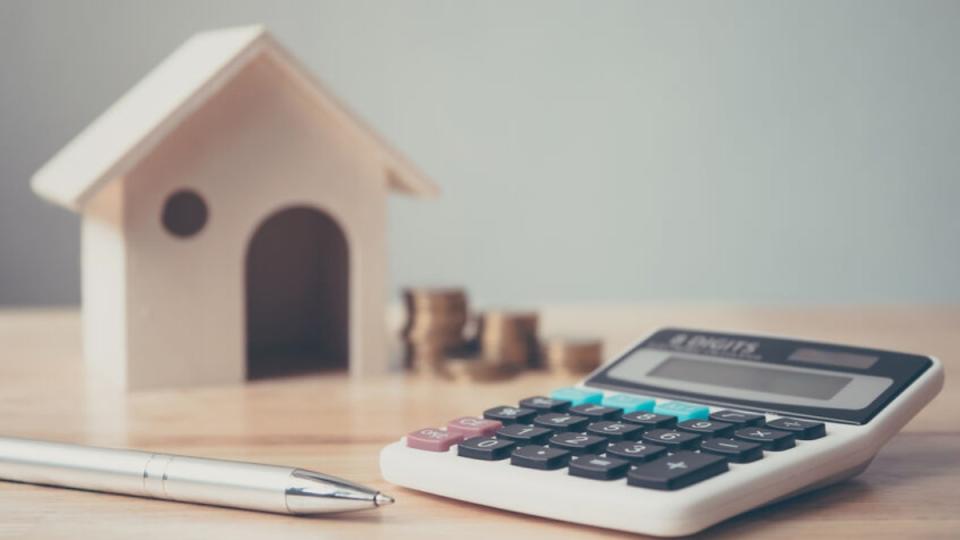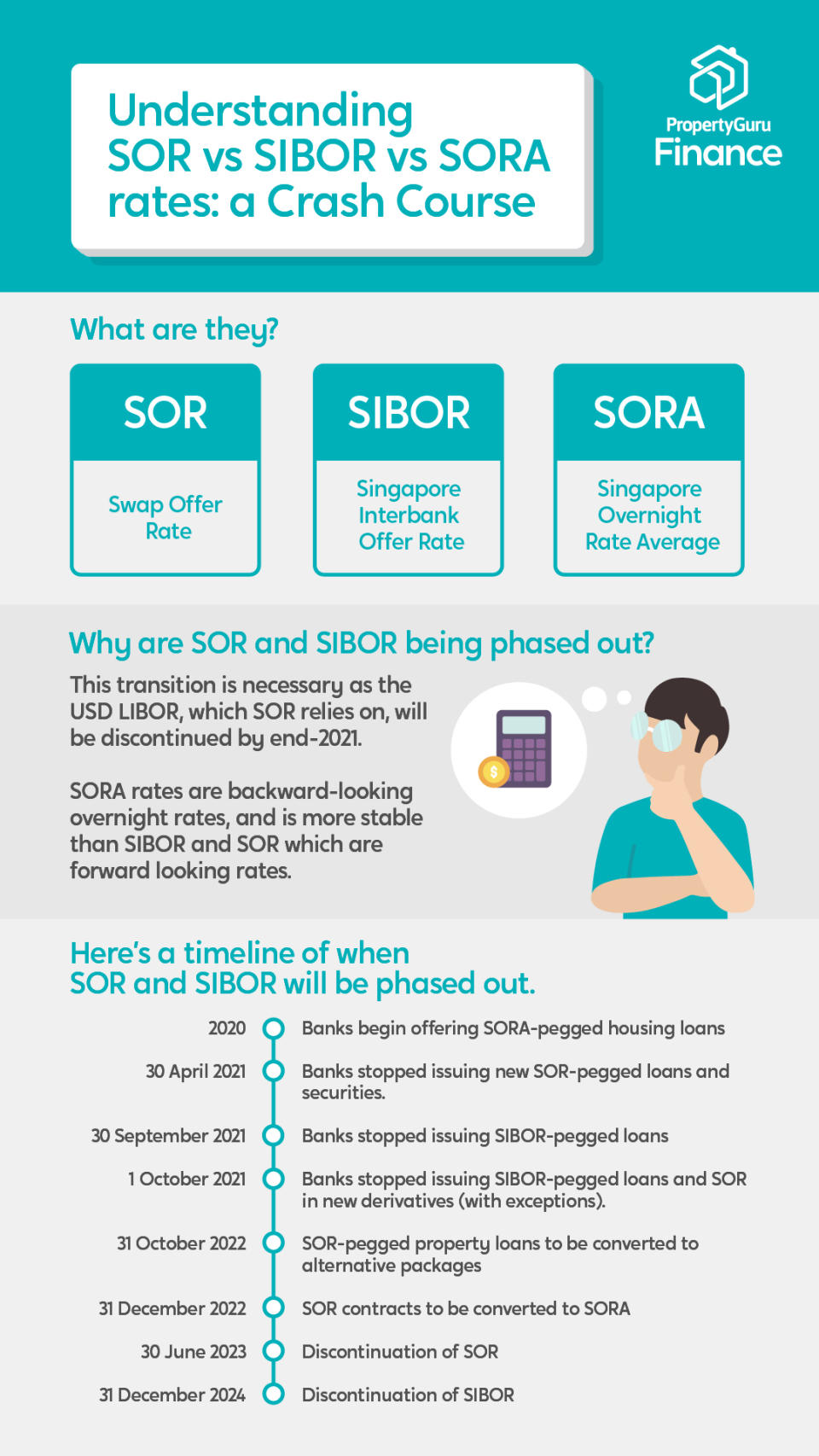When you’re scanning through home loan packages online, you might come across something that looks like this: “3M SORA + 1.00%”. If you’re new to applying for home loans, you might have tons of questions. What is SORA? Why is there a “+” sign? How about SIBOR or SOR? What are reference rates even? Hold your horses, let’s break it down together.
The first part of the ‘equation’ refers to the compounding period; the second part is the reference rate used; the last part is the bank’s spread for their floating rate home loans.
To help you learn more, we will explain what are SOR, SORA, and SIBOR rates and how they affect your home loan interest rates in this article.
SORA vs SIBOR vs SOR: An Overview
SORA rate (Singapore Overnight Rate Average) | The volume-weighted average rate of overnight SGD borrowing transactions by banks in Singapore |
SIBOR rate(Singapore Interbank Offered Rate) | Rate that Singaporean banks can borrow money from each other via the interbank market |
SOR rate (Swap Offer Rate) | Rate of borrowing SGD synthetically, by borrowing USD and converting it to SGD in the foreign exchange market |
Put simply, SORA, SIBOR and SOR are reference rates used in home loans in Singapore. They are an interest rate benchmark used to set other interest rates. SORA, SIBOR and SOR are used to determine the final interest cost on loans with floating home loan interest rates.
Since SORA, SIBOR and SOR serve as a gauge for a bank’s cost of funds, banks must charge a premium on top of this cost in order to be profitable. This is known as the spread.
What Is SORA?
SORA is a fairly transparent interest rate benchmark that reflects the average rate of Singaporean banks borrowing funds overnight from each other. According to the Association of Banks in Singapore (ABS), the transaction-based benchmark is commonly monitored as a reflection of daily conditions in SGD money markets and is supported by a deep and liquid overnight funding market, making it a suitable alternative to SOR.
Loans with interest rates pegged to SORA enjoy greater stability. This is because the use of average SORA readings over a period reduces the effects of day-to-day volatility. Additionally, compounded SORA rates are backward-looking overnight rates, which are considered more stable compared to forward-looking term rates like SOR and SIBOR.
Other benefits of SORA include the fact that it has been published by MAS since 1 July 2005 (you can check out the historical records of SORA), which means there is a long historical time series that market participants can analyse and use to model trends for risk management, asset-liability pricing and trading purposes.
What Is SIBOR?
SIBOR stands for the Singapore Interbank Offered Rate, and it is the rate at which Singaporean banks can borrow money from each other via the interbank market. There are four SIBOR tenures: one, three, six, and 12 months.
SIBOR is calculated based on submissions of rates from a panel of contributor banks. Each working day,20 banks that form the panelof the Association of Banks in Singapore will submit rates they think they can borrow funds on the interbank market. After removing the top and bottom quartiles, SIBOR is then set as the average of the remaining submissions.
As SIBOR-pegged loans typically use a single day’s reading for each interest payment period, the downside would be that borrowers will be exposed to market conditions concentrated in one single day. Taking a spike in SIBOR occurring on a borrower’s date of loan reset as an example, the borrower would thus incur a higher interest payment for the period as opposed to when the rates have been reset on other days of the month.
What Is SOR?
SOR stands for the Swap Offer Rate, and explaining it is a little more complex. But to keep it simple, it is the cost of borrowing SGD if you had done so by first borrowing USD and then swapping it to SGD using a foreign exchange derivative. It is also calculated by the ABS.
Unlike SIBOR, however, for the purposes of assessing home loans, you can pretty much ignore it. While SOR was once also a popular reference rate, it has been completely phased out. Because of the USD component in its calculation, it is far more volatile compared to SIBOR – not an ideal trait for a reference rate.
SORA Rate to Replace SIBOR Rate by 2024
If you don’t know already, SIBOR and SOR rates are being phased out and replaced by SORA. Here’s a nifty chart which reflects these changes.
What SOR Borrowers Can Expect
The computation of SOR takes reference from the USD LIBOR. From 31 December 2021, LIBOR will “either cease to be provided or will no longer be representative for US Dollars”.Following the international regulator’s announcement of the USD LIBOR panel ceasing on 30 June 2023, SOR will also be subsequently discontinued.
As it is, the last SOR-pegged home loan was taken off the market in July 2017 and on 31 October 2022, all SOR-pegged property loans have been converted to alternative packages.
What SIBOR Borrowers Can Expect
Likewise, in line with global interest rate benchmark reforms, SIBOR will also be discontinued. The 6M SIBOR has already been phased out since 31 March 2022, while the more common 1M and 3M SIBOR will be phased out by 31 December 2024.
Leading up to the discontinuation of SIBOR, financial institutions have already stopped using SIBOR in their calculation of interest rates for new loan packages.For those with loans based on the 6M SIBOR, your bank should have already made the switch to an alternative loan package.
But if your loan is tied to the 1M or 3M SIBOR, you have two options:
Take up a SORA conversion package, or
Opt for any other loan package offered by the bank
What Happens if You Take up a SORA Conversion Package?
Upon the borrower’s consent, the bank will convert the existing SIBOR loan to a SORA loan. Borrowers will not incur any additional fees or lock-in period should they opt for the SORA conversion package.
Recomputing your Mortgage Servicing Ratio (MSR) and Total Debt Servicing Ratio (TDSR) will not be required for borrowers who opt for a SORA Conversion Package with their existing bank. If you’re intending to refinance your property loan with another bank, it’s worth checking if any other TDSR exemptions apply.
Taking action to convert to a SORA package before SIBOR is entirely phased out has other perks too. A big one is minimising disruptions to your loan when SIBOR is discontinued. You also want to avoid scrambling to take up any mortgage package your bank offers you.
Think about it: it’s more advantageous to switch to a SORA home loan when youcan, and not when youhave to. This way, you are in a better position to secure a home loan with favourable interest rates that are suited to your financial situation.
[ArticleCallout]{ “title”: “Understanding SORA Interest Rates: Why You Should Pick a SORA Home Loan in 2023”, “excerpt”: “Read more here.”, “link”: “https://www.propertyguru.com.sg/property-guides/pgf-sora-interest-rates-home-loans-69546”, “image”: “https://img.iproperty.com.my/angel/1110×624-crop/wp-content/uploads/sites/3/2022/09/SORA-interest-rates-and-home-loans.jpg” } [/ArticleCallout]
Understanding SORA Rate Trends and Home Loan Interest Rates
The most recent interest rate hike in May 2023 saw the US Fed funds rate being adjusted to a target range of between 5% and 5.25%; in early 2022, it was near zero. This was the tenth consecutive hike in 14 months. Alongside these interest rate hikes, you can see that the 1M, 3M, and 6M SORA rate trends moved in tandem with market fluctuations.
But should you worry about the SORA rates continuing on their upward hike? And if you convert to a SORA-pegged home loan, will your mortgage rates increase drastically too?
According to Paul Wee, Vice President – PropertyGuru Finance, “the adjustment of 25 basis points during the May 2023 hike was anticipated. But what is important is to listen to the US inflation data, which revealed that inflation has dropped. Alongside the US Fed suggesting that the latest interest rate hike may be the last one for now, we are expecting easing pressure on mortgage interest rates.”
What Happens if You Choose Other Home Loan Packages Offered by Banks
SORA is a very transparent option as no one bank can influence the rate. And because the spread each bank charges over SORA is clear to see, it is easy tocompare home loans against one another.
The alternative is going for a home loan pegged to a board rate, which is an interest rate fixed internally by a bank. Board rates have little to no transparency as they are solely at the bank’s discretion, making an apple-to-apple comparison more difficult.
If you compare the most competitive mortgage rates on PropertyGuru Finance, you’ll notice that – despite the rate hikes – a lot of the cheaper packages (with the lowest home loan interest rates) are actually SORA packages.
That said, it is worth noting that most banks have a floor rate that protects them in case the benchmark interest rate (SORA, in this case) falls too low. How this works is that if SORA fell below that minimum rate, your final interest rate would be based on that minimum rate plus the bank’s spread (instead of SORA plus the spread).
Choosing a SORA Home Loan? Get the Best Home Loan Rates on PropertyGuru Finance
Financing is a major part of purchasing property, whether for investment or own-stay purposes.
At PropertyGuru Finance, we partner with all the major banks in Singapore to give you access to the best rates possible – whether SORA-pegged or otherwise – and limited-time bank promotions.
If you prefer to research independently first, you may read ourinformative guides on home financing. But if you’re looking for a home loan, we recommend you speak with one of ourMortgage Expertsfor in-depth and unbiased advice to help you navigate the market.
Chat with us on Whatsapp Fill up an online form
Disclaimer:Information provided on this website is general in nature and does not constitute financial advice.
PropertyGuru will endeavour to update the website as needed. However, information can change without notice and we do not guarantee the accuracy of the information on the website, including information provided by third parties, at any particular time. Whilst every effort has been made to ensure that the information provided is accurate, individuals must not rely on this information to make a financial or investment decision. Before making any decision, we recommend you consult a financial planner or your bank to take into account your particular financial situation and individual needs. PropertyGuru does not give any warranty as to the accuracy, reliability or completeness of information which is contained on this website. Except insofar as any liability under statute cannot be excluded, PropertyGuru and its employees do not accept any liability for any error or omission on this website or for any resulting loss or damage suffered by the recipient or any other person.


